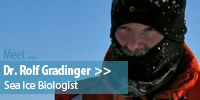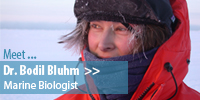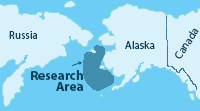 |
|||||||||||||||||||||||||||||||||
At the northern fringe of the Pacific Ocean, along the United States’ most remote boundary, lies the Bering Sea. Covering an area more than three times the size of Texas (nearly 900,000 sq. mi.), and supporting some of the most valuable fisheries in the world, the Bering Sea’s remote waters have attracted explorers for thousands of years. This cold maritime environment is home to a huge diversity of life. From migrating whales to clams, seabirds, seals and fish, organisms in the Bering Sea have evolved to make up one of the world’s most unique ecosystems. The Bering Sea’s high northern latitude means nearly continuous daylight throughout the summer months. In contrast, the winters are long and dark. Winter conditions are so harsh that the surface of the ocean, over much of the Bering Sea, freezes. Organisms living in this region have had to adapt to these challenging, extreme, and changeable polar conditions. VIDEO: INTRODUCTION TO THE BERING SEA
Discover why the Bering Sea is important to people in Alaska and around the world (1:50) Recently, people living in coastal areas, companies exploring and building along the coast, and researchers with an eye on the Bering Sea have observed significant and measureable changes. Sea ice has been arriving later in the winter. Animals are migrating farther north and the distribution of species is changing. Some animal populations are growing quickly, while others seem to be in decline. These changes directly impact everyone who relies on the Bering Sea. They make it harder for local communities to support their food and infrastructure needs, and harder for companies to plan on the expected ice or weather conditions two years down the road. VIDEO: ARCTIC MELT IN ACTION
This NOAA visualization illustrates how sea ice cover in the Arctic changes annually across the seasons. Compare 2012's record melt season to the historic (1979-2000) median. (0:34) Changes in the Bering Sea won’t just affect people and their activities; they may also impact the balance of the marine ecosystem. This has scientists concerned. They realize that before we can make predictions about what these changes may mean for this important marine ecosystem, we need to learn more about the area as it is now. Dr. Rolf Gradinger and his colleagues at the University of Alaska Fairbanks are one group of researchers working to better understand the Bering Sea. Observations they've made have sparked scientific questions and inspired futher research about the Bering Sea food web. VIDEO: INTRODUCTION TO THE RESEARCH PROJECT
Dr. Rolf Gradinger explains why the team is interested in studying the Bering Sea ecosystem. (1:30) Dr. Rolf Gradinger and his team know that among the many species of plant and animal life living with the sea ice are marine plants called algae. The team wants to better understand the role that this sea ice algae plays in the entire Bering Sea food web during the spring. Dr. Gradinger knows that to accurately hypothesize the importance of this algae bloom, the researchers will need to study the science of sea ice as well as discover what types of living things make their homes throughout the sea ice ecosystem.
|
WHO IS STUDYING SEA ICE?
|
||||||||||||||||||||||||||||||||
 |
|||||||||||||||||||||||||||||||||














